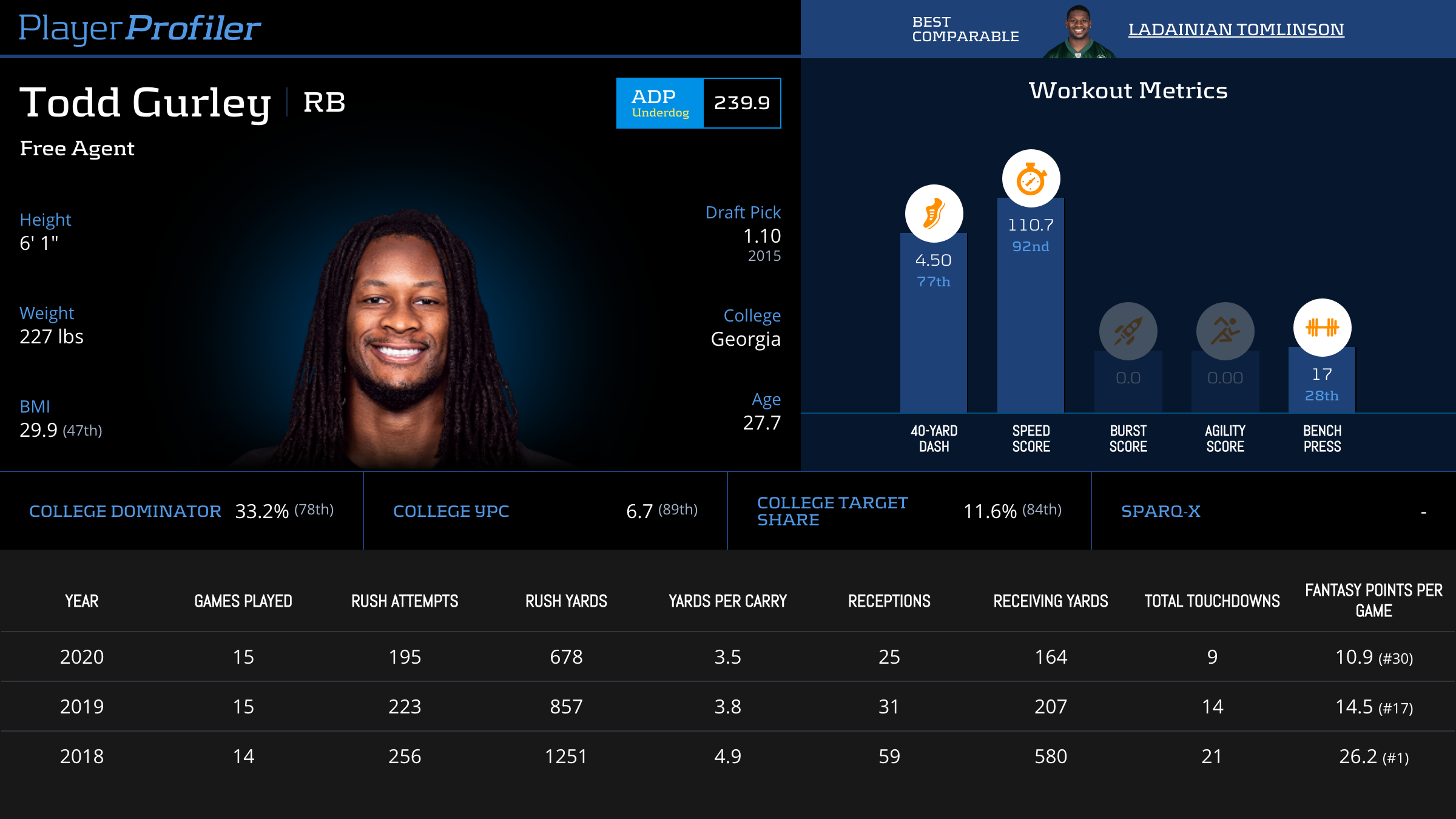Have you drafted the wrong running back in the past? Are you tired of the Clyde Edwards Helaire’s of the fantasy world letting you down? Want to find yourself the next Alvin Kamara or Jonathan Taylor? Well, you’ve come to the right place. Consider this article dating advice for finding the right running back in your fantasy leagues. This article asks, what qualities make up the RB1 in fantasy football? This is part one of a series of articles that will be breaking down this topic, so stay tuned!
Running backs are fickle in fantasy football. There, I said it. Over the last five seasons, there have been five different RB1s in fantasy football PPR formats. When I say RB1, I mean the running back that scored the most overall points in fantasy football in a respective season.
2017: Todd Gurley
2018: Saquon Barkley
2019: Christian McCaffrey
2020: Alvin Kamara
2021: Jonathan Taylor
When I examined the last five RB1s in fantasy football, I found some interesting data.
RB1 Qualities
Talent
All five of the previously mentioned running backs posted an elite score on the playerprofiler.com website. This means the running back scored in the 90th-percentile or greater in either the 40-yard dash, Speed Score, Burst Score, or Agility Score. An example of this is found when we look at Todd Gurley‘s playerprofiler.com page:
Gurley’s elite Speed Score gave him a skill that no doubt helped him on his path to becoming the RB1.
Dominator Rating
The running backs proved they were dominant either in college or at the professional level. In fact, all of the running backs except Alvin Kamara posted at least a 75th-percentile College Dominator rating. Kamara posted two seasons of a top 10 Dominator Rating before he broke out in 2020. In order to be an RB1 in fantasy football, their Dominator Rating needs to be at least 34.0-percent. This was what Kamara’s was the year he became the RB1 in 2020. This was the lowest mark of any RB1 over the last five seasons. It’s fair to say, this is a mark any potential RB1 should be able to hit.
Receiving Ability
The running backs had multiple paths to fantasy glory. This means they must be able to catch the ball as well as run the ball. The minimum threshold we are looking for would be a 10.6-percent Target Share, which is what Jonathan Taylor had a season ago. Now, I’ll admit, that’s relatively low compared to those running backs that came before him. Taylor’s Target Share percentage ranked No. 18 in the NFL. He was able to make up for it with his insane Breakaway Runs and touchdowns. He ranked No. 1 in the league with 23 Breakaway Runs and 20 touchdowns in 2021. All four of the other running backs ranked top five in Target Share during their respective RB1 seasons.
Opportunity
It might be another obvious quality, but the running back has to get the opportunity. This means they must be on the field. Ideally, they need to be on the field when the team has a strong chance of scoring a touchdown. This comes in the form of two statistics: Snap Share and red zone touches. Now, of course, this category has an outlier. Darn you Alvin Kamara and your 58.8-percent Snap share, which ranked No. 16 in the NFL during the 2020 season! Kamara was able to overcome his average Snap Share with an insane, top-ranked 22.5-percent Target Share. Out of the other four RB1s, the lowest Snap Share was Jonathan Taylor’s 68.6-percent (No. 5) mark.
What every single RB1 had in common was they all ranked in the top five when it came to red zone touches. I’m sure this had no small part to play in four out of the five running backs finishing No. 1 in touchdowns, with the other running back finishing No. 3 in touchdowns.
Now, let’s turn our eyes to the future. After analyzing the past five seasons of running back production in fantasy football, I’ve noticed some trends that qualify or disqualify a running back from contention to be the RB1 in fantasy football. This is pivotal as we sort through the running backs this year to determine who the best producers are going to be.
Conclusion
So, have I learned anything from all that research? I hope so. Here are the criteria I developed from looking at the last five RB1s:
In order to be the RB1, the running back must have an elite trait (90th-percentile or better according to playerprofiler.com). He must post a 75th-percentile or better College Dominator Rating or have at least one season where they post a top 10 dominator rating while playing running back in the NFL. The running back must have multiple paths to fantasy points, with four out of five past RB1s ranking in the top five in Target Share. The player must have a top-five Snap Share amongst running backs, or enough Target Share to offset the lack of Snap Share (Alvin Kamara). The running back must rank top five in red zone touches during their RB1 season.
In my next article, I will break down the candidates who are bound to have a claim to the RB1 spot in fantasy football.



